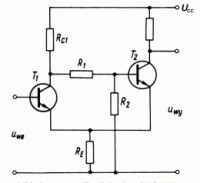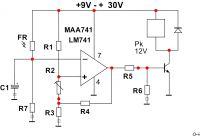wienshu wrote: What parameter starts and conditions further calculations?
In a very rough calculation of the circuit's switching points, it is assumed that the transistors have high current gain (i.e. their base current is negligible) and that they both have the same characteristics (mainly the voltage Ube).
With these assumptions, looking at the circuit, we see a classic differential amplifier with a common emitter resistor (this is especially visible if we draw T2 with the base to the right).
So the properties of such a system show that the key issue is the voltage difference between the bases.
And it is at these moments when this voltage difference between the bases crosses zero that the differential amplifiers change from one conductive transistor to the other. And here in this system, additionally due to the positive feedback, there is a switch from one stable state to another (at the output).
Since the base voltage T1 is the input voltage and it is given, the key issue in calculating the flip-flop characteristic is to find out what voltage is on the basis of T2 in both states of the flip-flop. Possibly what are the voltages on the T1 collector, because from this point we have the R1 / R2 divider.
When the input voltage is lower than the lower switching threshold (T2 is conducting, T1 is not) the calculation is simple. We have an ordinary divider from three resistors Rc1, R1, R2 on the supply voltage and we can easily calculate the voltage on the basis of T2.
So we have calculated "upper" voltage, when reached which the flip-flop switches to the state T1 conducts, T2 does not.
A little more trouble with the "lower" voltage, but if we assume that R1 + R2 have a much greater value than Re, we have a series connected on the power supply Rc1, a saturated transistor T1 (i.e. around 0.5V) and Re. From this we calculate the collector voltage T1.
From this calculated voltage, taking into account the divisor R1 and R2, we calculate the base voltage T2. This is the "lower" switching voltage of the flip-flop.
It is true that this method of calculation is not very accurate, but in practice it is also difficult, due to the dispersion of parameters, to exactly hit the assumptions.
You can see your layout live here:
Schmitt simulation and move the Resistance slider to the right, specifying the input voltage, where the thresholds differ slightly from these approximate calculations. But this simulation is also an approximation.






